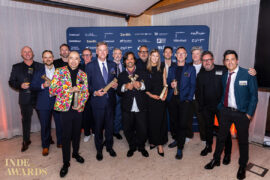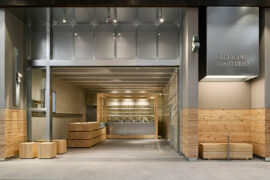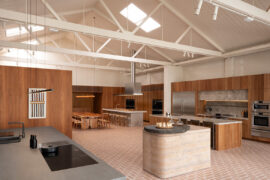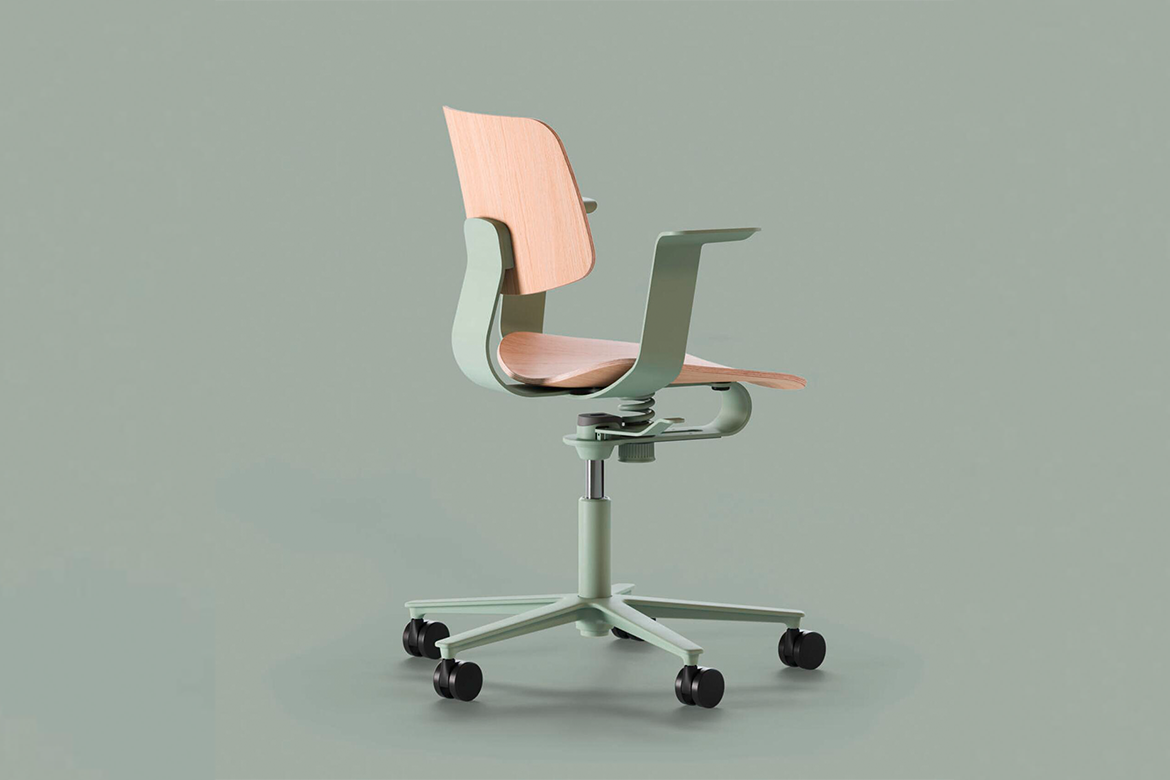Mafi joins the 2018 INDE.Awards as the Official Partner of the ‘Wellness Space’ Award, continuing the brand’s commitment to the pursuit of wellness through design in all its forms.

I share five lunchtimes a week with seven or eight other women (and sometimes a man or two). For just shy of an hour, we plié, plank, and port de bras our way through a barre class, inching on tip toes toward the final shavasana. Our sweat-wicking active wear keeps us dry as we inhale the humid air, which is thoughtfully scented with atomised essential oils from a nearby CBD spa. Afterward, we spray ourselves with natural, aluminium-free deodorants, sip from filtered water bottles, and grab a protein ball. Welcome to the age of wellness.
Around the world, the wellness craze has captured hearts, imaginations, and – let’s face it, wallets. In 2015, the Global Wellness Institute estimated the worth of the international wellness institute as around $3.7 trillion, or just under 3.5% of the annual gross world product. A veritable shape shifter, wellness knows many faces: for some, it means fitness classes and gyms, for others it means meditation, spas, and complementary or alternative medicine. For others still, wellness extends to nutrition and healthy eating, in addition to workplace wellness and preventive and personalised medical care. And the variations keep coming.
Why has wellness caught on so strongly? Perhaps it’s a response to delayed mortality: faced with the reality that we will most likely live for longer than any of our ancestors, many of us are evaluating our health in the long term. As we become increasingly aware of the effects of today’s actions on our bodies and minds of tomorrow, preventive medicine is gaining ground. Once considered luxuries, trips to the massage therapist, nutritionist, and exercise physiologist are now well enfolded into the mainstream, and are simply seen as investments in long-term health. With this comes a growing recognition of the importance of mental health, which in turn has facilitated the rise of mindfulness and meditation-based programs.
Or maybe the appeal of wellness lies – at least in part – in its gentleness. For people who don’t themselves athletic, wellness is a welcoming portal into the world of protein powders and exercise. In a sense, it’s fitness with the sportiness dialled down. Exercise is no longer outcome-based (Get a six-pack!), but instead something enjoyed for its own sake (Relax into the stretch!). Wellness is distinct not in practice but in its softly-softly approach: my sister – an avid fan of circuit training – was bemused in a recent barre class when the instructor gently levelled my hips in a plank: “only if that’s comfortable”. “At my gym,” my sister said, “They just sit on you until you’re low enough.”
In some ways, the wellness industry is nothing new. When and Edith Zuckerman opened Canyon Ranch, “America’s first total vacation/fitness resort” in 1979, they had no way of knowing that they were harbingers of one of the 21st century’s biggest industries. Today, the notoriously upmarket Canyon Ranch’s offerings are standard wellness fare: spas, nutrition and beauty services, fitness classes, and traditional and alternative medicine. In 1979, however, wellness was a shakier pitch and Canyon Ranch got off to a bumpy start, building loyalty slowly and from the ground up. Still, the interest in self-care and a holistic view of health was there, and the Zuckermans soon opened a second Canyon Ranch in Lenox, Massachusetts in 1989.
The beauty of today’s booming wellness industry is that ubiquity has made a holistic approach to health accessible in way that it previously was not. The immersive luxury of Canyon Ranch is how available at increasingly affordable prices, and you can find entrances to it on virtually any street corner. From boutique fitness studios to massage parlours, naturopaths to spas, wellness in its many forms is now a fixture of the urban and suburban landscapes.
Indeed, like any other cultural wave, the wellness boom has trickled down. Much has been said about the consumer industries ancillary to wellness – “athleisure” wear, health foods, and fitness trackers amongst them – but the discussion rarely centres on the spaces that accommodate the wellness agenda. As diverse and multifaceted as the lifestyle they promote, today’s wellness spaces are emerging as a distinctive form of architecture and interior design that merits consideration in its own right.
Often, wellness spaces are linked by their focus on ample natural light, ventilation, and exterior sightlines; a strong relationship with nature and surrounds is encouraged, often by way of biophilic design. Colour and material palettes are typically muted to craft spacious, uncluttered interiors whose breeziness is emphasised with subtle soft furnishings and greenery. The wellness space perfectly captures its own zeitgeist: contemporary, refined, and the best possible version of itself.
In recognition of the ongoing upward arc of wellness, the 2018 INDE Awards are pleased to present a new category: The Wellness Space. Celebrating excellence in the design of health and wellness service spaces, this category honours design that places equal emphasis on procedure and the human experience. Fittingly, the 2018 Wellness Space award is presented by Mafi, an Austrian-born supplier of natural wooden floorboards renowned for its focus on ecological responsibility and the human experience.
Dating back to the first world war, Mafi has grown from a humble family operation in Salzburg, Austria to become one of the world’s leading providers of high quality and all-natural solid timber flooring. Mafi was the first company in the world to design a lacquer-free, completely naturally oiled flooring surface, and continues to pride itself on a strong environmental focus and catalogue of sustainable, future-oriented timber products. In 2008, the company expanded to Melbourne, where it soon developed a devoted client base that has since spread to Sydney, Adelaide, Perth, and Brisbane. Today, Mafi Australia is headquartered in Alexandria, a formerly industrial Sydney suburb that is fast reinventing itself as a burgeoning creative hub.
Mafi‘s growing popularity in Australia is no doubt linked to the wellness movement, which aligns strongly with the brand’s unwavering human and environmental focus. In the same way that wellness considers health as a big-picture question, Mafi approaches design from a wide format, full-colour point of view. Instead of viewing their flooring products as an isolated fit out element, Mafi recognises their importance in crafting harmonious, healthy spaces that nurture occupant wellbeing. Their chemical free, natural finish timber floors are ideal for creating warm, non slip surfaces that are naturally antibacterial, self cleaning, and extract atmospheric moisture, which otherwise contributes to the growth of germs and mould. Mafi is a proud partner of the National Asthma Council of Australia’s (NACA) Sensitive Choice Program, which recognises products that help alleviate the symptoms of asthma and allergies.
Timber has played a central role in the design boom surrounding wellness spaces, and for good reason. In many ways, its relationship with health and wellbeing predates the wellness craze: timber has long been used to build saunas, steam rooms, and environmental retreats. The connection spans time and cultures – in the 19th century, when Henry David Thoreau wanted to live simply and reconnect with “the essential facts of life”, he retreated to a log cabin in the woods; in contemporary Scandinavia, the benefits of wooded environments on children’s learning and development are harnessed in mainstream schooling.
Rightly perceived as a natural alternative to synthetic materials such as laminate, concrete, and acrylic, timber is roundly regarded as a healthier choice than carpet or resilient flooring. Now, we have the research to back up what many before us have gleaned experientially: that timber is the ideal material for enhancing wellbeing within an interior space. In a widely cited report on the positive effects of timber, Planet Ark described the centrality of timber to creating spaces with many physiological, psychological, and environmental benefits. These include improved air quality through humidity moderation, reduced blood pressure and heart rate, and improvements of a person’s emotional state. Of course, these effects are compounded with timber’s ability to sequester carbon for extended periods, making it a key means of fighting climate change.
Though Mafi floors are a valuable addition to any interior space, they are a particular favourite amongst designers of wellness spaces including dental practices, spas, and boutique fitness studios. Free of harmful volatile organic compounds (VOCs) and formaldehyde, the floors support clean, healthy spaces that foster occupant wellbeing. Yet the benefits of Mafi flooring are both environmental and aesthetic. Mafi‘s signature all-natural oil finish allows designers unprecedented freedom to celebrate the distinctive beauty of raw, exposed timber, in addition to allowing them to explore the varied design potential of timber’s many species.
INDESIGN is on instagram
Follow @indesignlive
A searchable and comprehensive guide for specifying leading products and their suppliers
Keep up to date with the latest and greatest from our industry BFF's!

London-based design duo Raw Edges have joined forces with Established & Sons and Tongue & Groove to introduce Wall to Wall – a hand-stained, “living collection” that transforms parquet flooring into a canvas of colour, pattern, and possibility.

Merging two hotel identities in one landmark development, Hotel Indigo and Holiday Inn Little Collins capture the spirit of Melbourne through Buchan’s narrative-driven design – elevated by GROHE’s signature craftsmanship.

With the opening of the 2026 INDE.Awards program, now is the time to assess your projects, ensure photography is at hand and begin your submissions.

Hecker Guthrie brings a natural, material-led design to Green Cup’s new Chadstone store, pairing pine, steel and glass with a grab-and-go layout inspired by the brand’s fresh, organic ethos.

Former INDE Luminary LeAmon joins the Design Institute of Australia (DIA) following more than a decade as the inaugural Curator of Contemporary Design and Architecture at the National Gallery of Victoria (NGV).

The Fisher and Paykel Melbourne Experience Centre by Clare Cousins Architects with Fisher and Paykel Design and Alt Group has been awarded The Retail Space at the INDE.Awards 2025. As a winning project, it redefines the possibilities of retail architecture by creating an immersive, material rich environment shaped by place, culture and craft.
The internet never sleeps! Here's the stuff you might have missed

At the National Wool Museum, a new exhibition traces the evolution of Godfrey Hirst and its long-standing role in shaping Geelong’s industrial and design identity.

True sustainability doesn’t have to be complicated. As Wilkhahn demonstrate with their newest commercial furniture range.